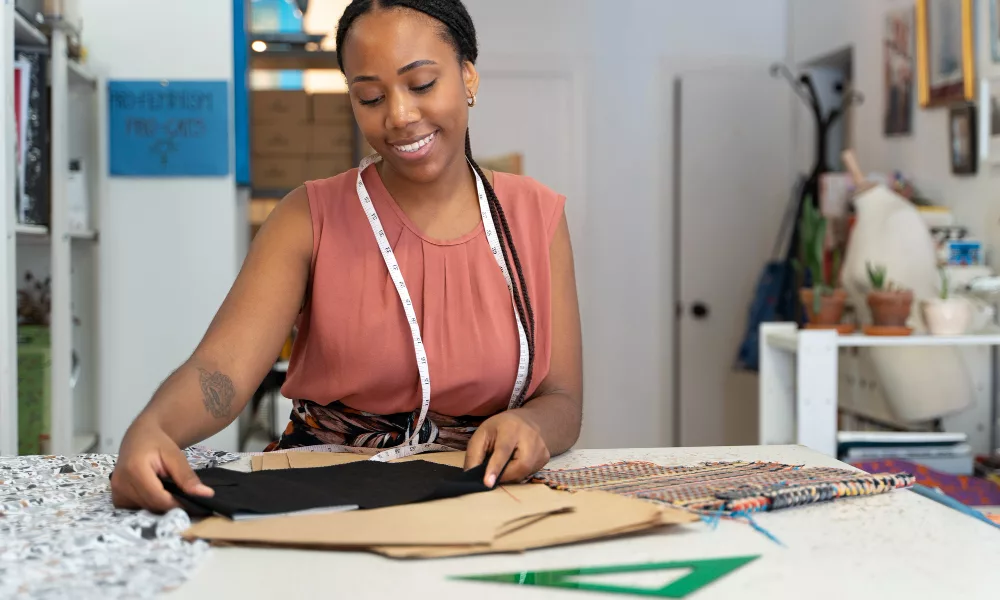
- March 29, 2023
- By Tolulope Adebayo
- Fashion
How to Become a Fashion Designer: Training, Certifications, and Salary Guide
Fashion designers produce and design garments and accessories. They could focus on high fashion, ready-to-wear, mass-market, sportswear, evening wear, accessories, and footwear. A Fashion Designer’s job is to study upcoming trends in fashion to produce futuristic designs. Fashion designers generate sketches, assess textiles, and create prototypes at the start of a design project.
Steps to Becoming a Fashion Designer
Step 1: Get a Degree
A degree is not essential in this industry. However, you should sharpen your skill through a degree program to enter this cutthroat market. Earning an associate’s or bachelor’s degree in fashion design allows students interested in the industry to have actual knowledge of figure drawing, computer-aided fashion design, fabrics, fashion history, and pattern making.
Step 2: Find Your Niche
Decide what aspect of fashion appeals to you; it could be high fashion, ready-to-wear, sports/fitness equipment, the mainstream market, sustainable fashion, etc. Before deciding which road to take, you’ll need to weigh each option’s benefits and drawbacks. You’ll also need to select a few sub-set areas for your fashion design from among these required fields. It would be best if you straddled a few; do not overextend yourself. It’s better to perfect your technique in one area first, then experiment in others once you’ve established a solid foothold in the market.
Common niches are:
- Outdoor, adventure, outerwear
- Women’s daywear, women’s evening wear
- Men’s daywear, men’s evening wear
- Accessories
- Boys’ wear and girls’ wear; teenage wear
- Sportswear/fitness/leisure wear
- Knitwear
- Bridal wear
Step 3: Get Skills
As a fashion designer, you need more than a degree to succeed in this field. You need some Skills such as:
- Effective communication skills.
- Sewing and drawing skills. Complete proficiency in fundamental fashion construction skills, such as operating a sewing machine, is optional; however, clearly understanding the craft involved in creating your designs is advantageous. You are better positioned to choose the ideal fabric for your outfits when you know the various materials and the characteristics that set them apart.
- Creativity. Although most Fashion designers are naturally talented with creativity, you can develop this talent as a skill and put it to good use. You want people to be able to identify and appreciate your art, so try as much as possible to sharpen this skill by constantly practising.
Step 4: Look for Motivation
Draw inspiration from areas of genuine interest, such as people, music, art, history, architecture, and particularly architecture. Your motivation can include various visual references, such as images (even if they aren’t fashion-related), editorial sources, street style, and more. Use mood boards to organise and revise your ideas as they come to you.
Step 5: Sketch Your Ideas
The first step of a sketch is to begin visualising the design in your head. The second step of an illustration is to create a blueprint or image that will serve as a guide for the patternmaker to produce your prototype. These drawings should be minimalistic and flat, and they should convey the technical elements of your design, including sleeve length, darts, seams, overall length, shape, fit, and more. Attaching a swatch of fabric to the page will also help indicate the specific fabrics you intend to use.
Step 6: Create A Portfolio
As you progress in your career, you’ll want to create a portfolio that showcases your creativity and capabilities to potential employers. This portfolio can include class projects if you’re pursuing a degree, and it can demonstrate your skills in areas like sewing, pattern-making, and drawing.
Step 7: Get An Internship Or Entry-Level Job
At the beginning of your career, your primary goal should be to gain as much experience as possible. One way to do this is by seeking internships or entry-level positions that bring you closer to the products and customers you aspire to serve. Collaborating with others, asking questions, and finding mentors can also help you grow and improve your work.
Expected Fashion Designer’s Salary Range
The average salary for fashion designers is $74,410 annually, equivalent to $6,200 monthly and $1,550 weekly.
When beginning your career in Fashion design, there are specific points to keep in mind.
Fashion designers must keep up with the latest trends since the industry changes each season. One way to stay updated is by regularly reading fashion magazines. While a fashion degree isn’t mandatory to become a clothing designer, having a basic understanding of art, design, and the fashion business can be beneficial to kickstart your career. Additionally, the fashion design industry is highly competitive, and it’s essential to take every possible step to stand out from the crowd.
Conclusion
For those starting a career in fashion design, it’s important to remember that success in this industry is not just about having a degree or innate talent. Using the resources available on the internet, practising constantly, seeking opportunities for apprenticeships, finding a job at a local store, collaborating with creative communities, and attending events in larger cities are all effective ways to gain experience and improve your skills. With hard work and dedication, it’s possible to succeed in fashion design, even without attending a prestigious school.
Related Blogs

How to Start a Career as a Fashion.
A fashion exporter is a vital link in the clothing manufacturing and retail chain. To become a successful fashion.
- March 29, 2023
- By Tolulope

How to Become a Fashion Photographer: Training, Certifications,.
As a fashion photographer, you direct all aspects of the shooting process, from lighting to clothing, hair, and makeup..
- March 29, 2023
- By Tolulope
